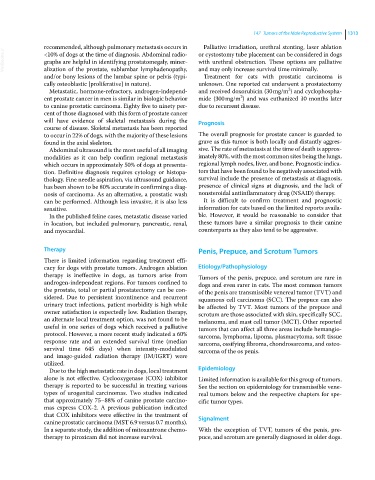Page 1375 - Clinical Small Animal Internal Medicine
P. 1375
147 Tumors of the Male Reproductive System 1313
recommended, although pulmonary metastasis occurs in Palliative irradiation, urethral stenting, laser ablation
VetBooks.ir <10% of dogs at the time of diagnosis. Abdominal radio or cystostomy tube placement can be considered in dogs
with urethral obstruction. These options are palliative
graphs are helpful in identifying prostatomegaly, miner
alization of the prostate, sublumbar lymphadenopathy,
and/or bony lesions of the lumbar spine or pelvis (typi and may only increase survival time minimally.
Treatment for cats with prostatic carcinoma is
cally osteoblastic [proliferative] in nature). unknown. One reported cat underwent a prostatectomy
2
Metastatic, hormone‐refractory, androgen‐independ and received doxorubicin (30 mg/m ) and cyclophospha
2
ent prostate cancer in men is similar in biologic behavior mide (300 mg/m ) and was euthanized 10 months later
to canine prostatic carcinoma. Eighty five to ninety per due to recurrent disease.
cent of those diagnosed with this form of prostate cancer
will have evidence of skeletal metastasis during the Prognosis
course of disease. Skeletal metastasis has been reported
to occur in 22% of dogs, with the majority of these lesions The overall prognosis for prostate cancer is guarded to
found in the axial skeleton. grave as this tumor is both locally and distantly aggres
Abdominal ultrasound is the most useful of all imaging sive. The rate of metastasis at the time of death is approx
modalities as it can help confirm regional metastasis imately 80%, with the most common sites being the lungs,
which occurs in approximately 50% of dogs at presenta regional lymph nodes, liver, and bone. Prognostic indica
tion. Definitive diagnosis requires cytology or histopa tors that have been found to be negatively associated with
thology. Fine needle aspiration, via ultrasound guidance, survival include the presence of metastasis at diagnosis,
has been shown to be 80% accurate in confirming a diag presence of clinical signs at diagnosis, and the lack of
nosis of carcinoma. As an alternative, a prostatic wash nonsteroidal antiinflammatory drug (NSAID) therapy.
can be performed. Although less invasive, it is also less It is difficult to confirm treatment and prognostic
sensitive. information for cats based on the limited reports availa
In the published feline cases, metastatic disease varied ble. However, it would be reasonable to consider that
in location, but included pulmonary, pancreatic, renal, these tumors have a similar prognosis to their canine
and myocardial. counterparts as they also tend to be aggressive.
Therapy Penis, Prepuce, and Scrotum Tumors
There is limited information regarding treatment effi
cacy for dogs with prostate tumors. Androgen ablation Etiology/Pathophysiology
therapy is ineffective in dogs, as tumors arise from Tumors of the penis, prepuce, and scrotum are rare in
androgen‐independent regions. For tumors confined to dogs and even rarer in cats. The most common tumors
the prostate, total or partial prostatectomy can be con of the penis are transmissible venereal tumor (TVT) and
sidered. Due to persistent incontinence and recurrent squamous cell carcinoma (SCC). The prepuce can also
urinary tract infections, patient morbidity is high while be affected by TVT. Most tumors of the prepuce and
owner satisfaction is expectedly low. Radiation therapy, scrotum are those associated with skin, specifically SCC,
an alternate local treatment option, was not found to be melanoma, and mast cell tumor (MCT). Other reported
useful in one series of dogs which received a palliative tumors that can affect all three areas include hemangio
protocol. However, a more recent study indicated a 60% sarcoma, lymphoma, lipoma, plasmacytoma, soft tissue
response rate and an extended survival time (median sarcoma, ossifying fibroma, chondrosarcoma, and osteo
survival time 645 days) when intensity‐modulated sarcoma of the os penis.
and image‐guided radiation therapy (IM/IGRT) were
utilized.
Due to the high metastatic rate in dogs, local treatment Epidemiology
alone is not effective. Cyclooxygenase (COX) inhibitor Limited information is available for this group of tumors.
therapy is reported to be successful in treating various See the section on epidemiology for transmissible vene
types of urogenital carcinomas. Two studies indicated real tumors below and the respective chapters for spe
that approximately 75–88% of canine prostate carcino cific tumor types.
mas express COX‐2. A previous publication indicated
that COX inhibitors were effective in the treatment of Signalment
canine prostatic carcinoma (MST 6.9 versus 0.7 months).
In a separate study, the addition of mitoxantrone chemo With the exception of TVT, tumors of the penis, pre
therapy to piroxicam did not increase survival. puce, and scrotum are generally diagnosed in older dogs.

